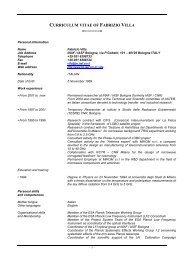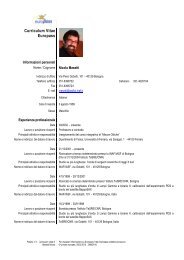booklet format - inaf iasf bologna
booklet format - inaf iasf bologna
booklet format - inaf iasf bologna
Create successful ePaper yourself
Turn your PDF publications into a flip-book with our unique Google optimized e-Paper software.
A.A. 2011/2012<br />
Temporal Data Analysis<br />
mation term e iωt we get the discrete times t k = k ∆t, k = 0,1,2,..., N − 1 with T = N∆t:<br />
(<br />
exp(iωt) → exp i 2πt ) (<br />
k<br />
= exp i<br />
T<br />
2πk ∆t<br />
N∆t<br />
We will use the abbreviation for the “kernel” W N as<br />
( ) 2πi<br />
W N = exp<br />
N<br />
Occasionally we will also use the discrete frequencies ω j<br />
)<br />
= exp<br />
( 2πi k<br />
N<br />
)<br />
≡ W k N<br />
(3.4)<br />
ω j = 2πj<br />
N∆t<br />
(3.6)<br />
related to the discrete Fourier coefficients F j (see below). The kernel W N has the following<br />
properties:<br />
(3.5)<br />
W n N<br />
N = e<br />
2πi n = 1 for all integer n<br />
W N is periodic in j and k with period N<br />
(3.7)<br />
We can define the discrete δ-function as follow:<br />
where δ k,k ′<br />
N−1 ∑<br />
j =0<br />
is the Kronecker symbol with the following property:<br />
W (k−k′ )j<br />
N<br />
= N δ k,k ′ (3.8)<br />
{ 1 for k = k<br />
′<br />
δ k,k ′ =<br />
0 else<br />
This symbol (with prefactor N) accomplishes the same tasks the δ-function had when doing the<br />
continuous Fourier trans<strong>format</strong>ion.<br />
3.1.3 Definition of the Discrete Fourier Trans<strong>format</strong>ion<br />
Now we want to determine the spectral content {F j } of the series {f k } using discrete Fourier<br />
trans<strong>format</strong>ion. For this purpose, we have to make the transition in the definition of the Fourier<br />
series:<br />
c j = 1 T<br />
∫ +T /2<br />
−T /2<br />
f (t)e −2πi j /T dt −→ 1 N<br />
N−1 ∑<br />
k=0<br />
(3.9)<br />
f k e −2πi j k/N (3.10)<br />
with f (t) periodic of period T .<br />
In the exponent we find k∆t/N∆t, meaning that ∆t can be eliminated. The prefactor contains<br />
the sampling raster ∆t, so the prefactor becomes ∆t/T = ∆t/(N∆t) = 1/N. During the transition<br />
M.Orlandini 45

















